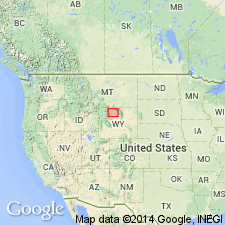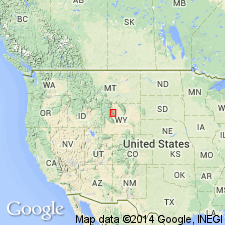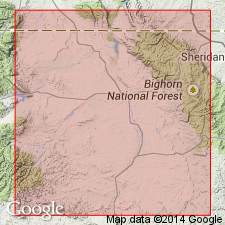
- Usage in publication:
-
- Willwood formation
- Modifications:
-
- Named
- Dominant lithology:
-
- Shale
- Sandstone
- Conglomerate
- AAPG geologic province:
-
- Bighorn basin
Summary:
Name applied to red-banded strata in the Bighorn basin of WY conformably above the Polecat Bench or Fort Union formation and below the Tatman formation. Named for the Willwood Division of the Shoshone Reclamation project, between Shoshone River and northeast slope of McCulloch Peaks, Park Co, WY, Bighorn basin. Called Wasatch formation in earlier reports. No type locality designated. Consists of about 2,500 ft of variegated shale, numerous beds of white and yellow sandstone composed of unsorted grains, and locally conglomerate lenses. Areal extent map. Yields Clark Fork fauna in lower part, Lost Cabin fauna in upper part, and Gray Bull and Lysite faunas in middle. Thicknesses of as much as 6,000 ft reported for rocks formerly called Wasatch, now assigned to Willwood. Discussion of individual exposures and of faunas. Deposited in a forested lowland under warm temperate conditions. Presence of pre-Cambrian pebbles in the conglomerates suggests erosion of cores of adjoining uplifts in early Eocene time.
Source: GNU records (USGS DDS-6; Denver GNULEX).

- Usage in publication:
-
- Willwood formation*
- Modifications:
-
- Contact revised
- AAPG geologic province:
-
- Bighorn basin
Summary:
Pg. 1871 (fig. 5), 1875 (fig. 8), 1878 (fig. 9), 1886-1888. Willwood formation. In Greybull Valley, Park County, Wyoming, Underlies Pitchfork formation (new). Correlates with Wind River formation. Age is early Eocene. Report includes correlation chart.
Source: US geologic names lexicon (USGS Bull. 1200, p. 4252-4253); supplemental information from GNU records (USGS DDS-6; Denver GNULEX).

- Usage in publication:
-
- Willwood Formation*
- Modifications:
-
- Age modified
- AAPG geologic province:
-
- Bighorn basin
Summary:
Paleocene-Eocene boundary can be placed at the 100 m level above the base of the Willwood Formation and within the Wasatchian land mammal age at Elk Creek (T50N, Rs93 to 96W), Big Horn Co, WY in the Bighorn basin. Boundary placement is based on the first occurrence of the Eocene index pollen PLATYCARYA PLATYCARYOIDES. Below the 100 m level, the palynoflora is dominated by CARYAPOLLENITES VERIPITES and other taxa typical of the late Paleocene. Willwood also contains one of the most completely known sequences of Wasatchian mammal faunas. P. PLATYCARYOIDES occurs at or near the nannofossil NP9/NP10 (or Paleocene/Eocene) boundary at localities in SC, VA, AL, and CA. If P. PLATYCARYOIDES is a reliable fossil, the Willwood rocks below the 100 m level and in the lower part of the Wasatchian are Paleocene. Relationship of type Sparnacian Stage, the uppermost Paleocene of the Paris basin to the marine microfossils is uncertain. Most prefer to use the marine section rather than rely on correlation with the Paris basin.
Source: GNU records (USGS DDS-6; Denver GNULEX).
For more information, please contact Nancy Stamm, Geologic Names Committee Secretary.
Asterisk (*) indicates published by U.S. Geological Survey authors.
"No current usage" (†) implies that a name has been abandoned or has fallen into disuse. Former usage and, if known, replacement name given in parentheses ( ).
Slash (/) indicates name conflicts with nomenclatural guidelines (CSN, 1933; ACSN, 1961, 1970; NACSN, 1983, 2005, 2021). May be explained within brackets ([ ]).

